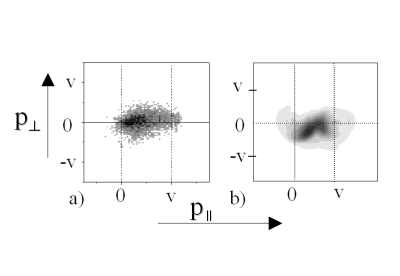
Figure 1: a)experiment b)theory (v is the projectile velocity and atomic units are used.)
INTERMEDIATE ENERGY IONIZATION OF HELIUM BY PROTON IMPACT
E. Edgü-Fry, C. L. Cocke and E. Sidky
J.R. MacDonald Laboratory, Department of Physics
Kansas State University, Manhattan, Kansas, USA
Ionization is well understood in ion-atom collisions where projectile velocities are much greater than that of target electrons. This is not the case when these velocities are comparable. Dörner, et. al.1 have shown for low energies (5-15 keV) ejected electrons preferably lie in the scattering plane and come away with a velocity between that of the target and the projectile. Another outcome of their experiments was that the transverse electron momenta lay in the collision plane and showed a two-finger structure. The center of the transverse electron momentum oscillated toward and away from the recoil with changing energy. On the other hand Abdallah, et. al.2 and Weber, et.al. 3 did similar experiments for higher energies (above 200 keV) and saw rather different pictures: electron momenta were concentrated more around the target center. This is not unexpected since these energies are considered quite fast in such a collision. Wood, et. al.4 did a calculation for the same collision for 100 keV and still observed a concentration of electron momenta peaked near the potential saddle. Our goal is to investigate ion impact ionization for the transition from low to high impact velocity. When exactly do ejected electrons become more target centered? As we go higher in energy slowly reaching 100 keV will we still see further oscillations in the electron momenta distributions?
The technique we have used in our experiments is Cold Target Recoil Ion Momentum Spectroscopy (COLTRIMS). The experiments were conducted at the KSU-CRYEBIS facility and the setup used is described in great detail in a previous work5. We started our experiments at 20 keV and carried them to 100 keV. We saw that, at the lowest impact energy, the electron momenta lie close to the saddle point and as the energy increases they slowly move towards the target center.
There appears to be a shift in the electron distribution from one side of the beam axis to the other. Figure 1a shows electron momentum distributions for 50 keV integrated over impact parameters 0.5 a.u. to 6 a.u.
We also investigated the proton-helium collision system theoretically by the two-center momentum space discretization (TCMSD) method6. TCMSD assumes classical straight-line trajectories for the nuclei and solves the time-dependent Schrödinger equation for the momentum space wave function. The target helium atom is treated with a one-electron approximation using a spherically symmetric screened Coulomb potential that reproduced the band levels of the helium atom. Calculations were carried out between 15 and 100 keV at impact parameters b=1.2 and b=2.0 a.u., corresponding to the maxima of the ionization probability at 15 and 100 keV respectively. Figure 1b shows our theoretical result for 50 keV at a fixed impact parameter (1.2 a.u.). The evolution of the ejected electron momentum distributions as a function of impact energy will be compared to the experimental results.
Figures:

References:
l) R. Dörner, et. al., Phys. Rev. Lett. 77, p.4520 (1996)
2) M.A. Abdallah, Landers et. al., in X-Ray and Inner-Shell Processes, edited by R.W. Dunford, et. al. (2000)
3) Th. Weber, et. al., J. Phys. B 33, p.3331 (2000)
4) C.J. Wood and R.E. Olson, J. Phys. B 29,L257 (1996)
5) M.A. Abdallah, et. al., NIM B 154, p.73 (1999)
6) E.Y. Sidky and C.D. Lin, J. Phys B 31, p.2949 (1998)
This work was supported by the
Chemical Sciences, Geosciences and Biosciences Division,
Office of Basic Energy Sciences,
Office of Science,
U.S. Department of Energy.
Submitted to ICPEAC 2001, July 2001 in Santa Fe, NM.
This abstract is also available in Postscript or Adobe Acrobat formats.
|
|